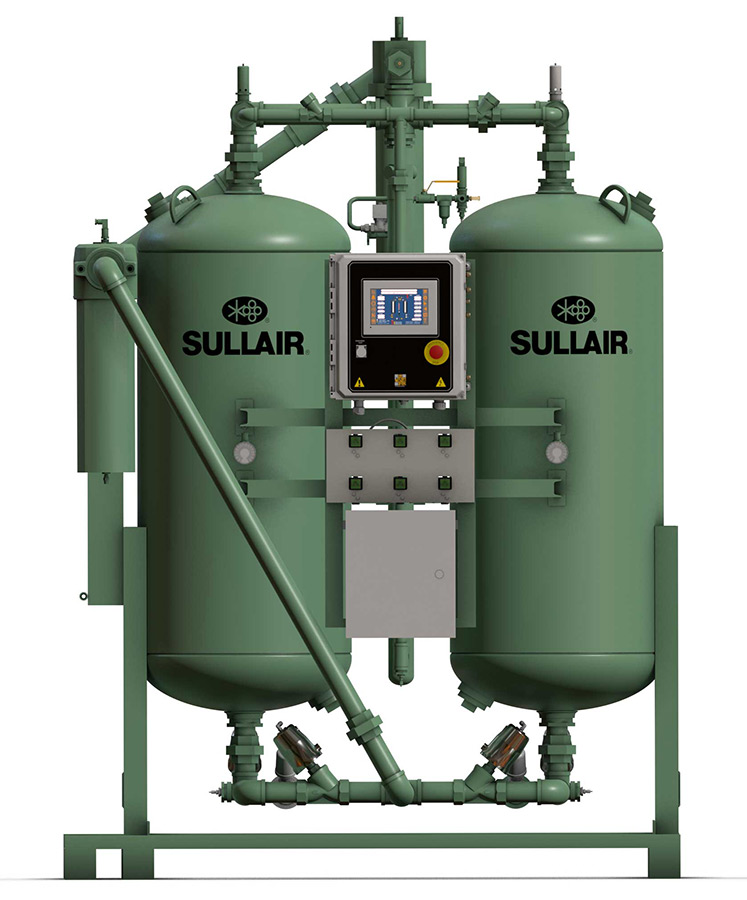
Knowing how a desiccant compressed air dryer works can help you decide if it’s the right type of dryer for your compressed air application. But before we talk about how a desiccant dryer dries air, it’s helpful to take a step back and understand why your compressed air system needs dry air at all.
A note on dry air: The dryness of air is formally measured by its dew point. The lower the dew point, the dryer the air. The term “dry” without a specific dew point given is relative to the needs of the process, use, or application.

Your compressed air system could need dry compressed air for a number of reasons:
So now that we know why we need dry compressed air, let’s talk about how desiccant dryers create it.
The short answer is that desiccant dryers remove moisture from the compressed air stream chemically using a process called adsorption.
The much longer answer has to do not only with adsorption, but the entire desiccant drying process (adsorption and desorption), pre- and post-filtration, and even the type of desiccant used.
Compressed air contains contaminants that can adhere to the surface of desiccant beads (often referred to simply as desiccant). This decreases the efficiency of the desiccant by reducing the amount of moisture it can adsorb over time.
Pre-filtration minimizes contamination of the desiccant by removing particulates from the air stream before the air reaches the desiccant bed. Reduced contamination can extend the life of the desiccant beads, which can reduce operating costs by requiring them to be replaced less often.
In order to continuously provide dry air downstream, a desiccant dryer needs to:
Desiccant dryers manage the process of drying air and regenerating desiccant by using paired towers, coordinating adsorption and desorption between the two towers (A and B) by cycling through a series of stages.

Drying: Tower A’s inlet valve opens and it starts receiving saturated compressed air. As this wet air flows through tower A, the desiccant beads adsorb water vapor, drying the air stream. This dry compressed air stream exits tower A and flows downstream. In heatless and externally heated dryers, a small portion of this dry air (“purge air”) is redirected towards tower B for use in regeneration.
Regeneration: At the same time, the exhaust valve of tower B opens and either atmospheric air (heated blower purge dryers) or purge air rapidly lowered to atmospheric pressure (heatless and externally heated dryers) flows across tower B’s desiccant. In externally heated and heated blower purge dryers, the air temperature is also raised, increasing the air’s moisture capacity. As this lower pressure and possibly heated dry air flows through tower B, the desiccant releases its moisture into the air stream, which exits tower B into the atmosphere.
Tower B’s exhaust valve is closed and the tower is re-pressurized. Once the pressure reaches the compressed air stream’s pressure, tower B is ready to start the drying process.
Drying: Tower B’s inlet valve opens and it starts receiving saturated compressed air. As this wet air flows through tower B, the desiccant beads adsorb water vapor, drying the air stream. This dry compressed air stream exits tower B and flows downstream. In heatless and externally heated dryers, a small portion of this dry air (“purge air”) is redirected towards tower A for use in regeneration.
Regeneration: At the same time, the exhaust valve of tower A opens and either atmospheric air (heated blower purge dryers) or purge air rapidly lowered to atmospheric pressure (heatless and externally heated dryers) flows across tower A’s desiccant. In externally heated and heated blower purge dryers, the air temperature is also raised, increasing the air’s moisture capacity. As this lower pressure and possibly heated dry air flows through tower A, the desiccant releases its moisture into the air stream, which exits tower A into the atmosphere.
Tower A’s exhaust valve is closed and the tower is re-pressurized. Once the pressure reaches the compressed air stream’s pressure, tower A is ready to start the drying process.
The four stages above make up one drying cycle. When a drying cycle ends the next starts automatically as long as the desiccant dryer is running.
Some types of desiccant can shed small particles, either due to saturation or pressure swings, a phenomenon known as “desiccant dusting.” To prevent this “dust” from contaminating downstream tools, products, and processes, the compressed air stream is filtered again after it leaves the desiccant bed.
The type of desiccant used can affect many aspects of dryer performance, in particular the dew point of the dryer. The most common desiccants used and their dew points are:
Desiccant dryers are most commonly used when a process needs very dry air (i.e. air with a very low dew point), including but not limited to:
Because moisture does not condense in a desiccant dryer, they are also frequently used for any applications that have ambient conditions not suitable for other types of dryers, for example in outdoor environments that reach sub-freezing temperatures.
If you’re not sure if a desiccant dryer is the right fit, you should always consult an expert to help you configure your system. Their years of experience in configuring compressed air systems across a wide variety of applications can help ensure you get the most economical drying solution that meets the needs of your application and operating conditions.
Use the checkboxes to select the types of cookies you want to accept, then press the “Save Settings” button. View our Privacy Policy.